Crushed recycled concrete and brick
Crushed recycled concrete (CRC) and recycled brick are primarily derived from construction and demolition waste. Contaminants such as plastic, timber and steel are removed, materials are subsequently crushed and screened before incorporation into infrastructure applications.
How is it processed?
In Australia, several resource recovery facilities process construction and demolition waste. Generally, processing includes screening the material for removal of contaminants, sorting and crushing to produce a range of recycled products for various end uses.
Environmental, health, and safety
CRC and recycled brick contain crystalline silica compounds, and asbestos is a historic construction material.
As prolonged and repeated exposure to these materials can be harmful, measures are implemented during recycling and construction to control and mitigate these risks. This may include the use of personal protective equipment, screening of materials, or use of water to prevent dust generation.
Applications
CRC and recycled brick can potentially be used in a number of infrastructure applications.
State road authorities allow up to 100% CRC and partial replacement with recycled brick to be used in some granular applications. These include aggregate replacement in:
- unbound and bound pavements
- non-structural concrete
- earthworks, drainage and backfill materials
- asphalt
- railway capping layer
Specifications
Main Roads Western Australia currently has specifications for the use of CRC and recycled brick in unbound and bound applications, such as:
- Specification 302 for Earthworks
- Specification 501 for Pavements
Specifications for the use of CRC in the rail space are available in Queensland such as:
- Standard QR-CTS-Part 6 for Earthworks
The Public Transport Authority outlines its requirements for pavements and concrete, including the use of CRC as an aggregate for concrete, in:
- 8880-450-067: Specification - Roads, Busways and Paths
- 8880-450-020: Specification - Design of Concrete
- 8880-450-021: Specification – Concrete durability
- 8880-450-028: Specification – Sprayed Concrete
Benefits and challenges
Use of CRC and recycled brick in roads and pavements can divert waste from landfill and reduce the demand for virgin quarried aggregates.
CRC has superior performance qualities compared to conventional virgin aggregates specified for granular subbase and base applications. Laboratory research has demonstrated that it may be feasible to use CRC in capping layers of railway structure.
Challenges may include high porosity and water absorption of CRC which can create workability variations. This can introduce risk and cost to the construction stage, although blending of the material can reduce this issue.
Previous use in Western Australia
The Kwinana Freeway Northbound Widening and Murdoch Drive Connection recently trialed CRC as a base material under full-depth asphalt. The recycled material was sourced from the Subiaco Oval demolition.
A number of local governments use CRC and recycled brick across Western Australia.

References
- Hall, B, Grenfell, J, Pandelidi, C, Yaghoubi, J, Chaudry, U, Lyons, M, O'Connor, G, Harrison, J & Feigen, D 2022, Best practice expert advice on the use of recycled materials in road and rail infrastructure: part A technical review and assessment.
- Hall, B, Grenfell, J, Pandelidi, C, Yaghoubi, J, Lyons, M, O'Connor, G, Harrison, J, Feigen, D & Xue, S 2022, Best practice expert advice on the use of recycled materials in road and rail infrastructure: part B sustainability impacts report.
- Queensland Rail, Earthworks, Standard QR-CTS-Part 6 (not publicly available)
- ecologiQ 2022, Recycled materials in rail infrastructure reference guide, viewed 2 October 2024, <https://bigbuild.vic.gov.au/__data/assets/pdf_file/0010/646912/ECQ_Rail_Infrastructure_Recycled_Materials_Guide.pdf>.
- Naeini, M, Mohammadinia, A, Arulrajah, A, Horpibulsuk, S & Leong, M 2019, 'Stiffness and strength characteristics of demolition waste, glass and plastics in railway capping layers', Soils and Foundations, vol. 59, no. 6, pp. 2238–53, doi: 10.1016/j.sandf.2019.12.009.